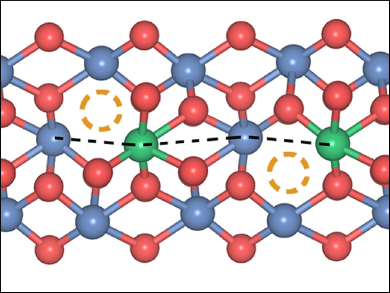Obtaining one-dimensional (1D) magnetoresistance in transition-metal oxides (TMOs) is challenging because it is difficult to produce 1D spin-tunable chains.
Changzheng Wu, University of Science & Technology of China, Hefei, and colleagues developed a strategy for the formation of superparamagnetic VO2 nanowires with a large, low-field negative magnetoresistance at room temperature. Vanadium dioxide, which has a 3d1 electronic configuration and is comprised of infinite 1D V–V atomic chains (pictured), holds great promise for the creation of chains with long-range order. However, pristine VO2 nanowires show no magnetoresistance effects.
The team chemically treated the VO2 nanowires under an atmosphere of hydrogen gas. This treatment resulted in the introduction of V3+ ions into zigzag V–V chains to result in superparamagnetic behavior owing to the production of weakly interacting ferromagnetic V3+–V4+ dimers. Electron transport measurements revealed that the hydrogen-treated VO2 nanowires exhibited a large low-field negative magnetoresistance at room temperature (–23.9 %, 300 K, 0.5 T).
When an external magnetic field is applied, ferromagnetic dimers tend towards parallel alignment, successfully reducing the energy barrier for electron hopping, resulting in decreased resistivity.
- Hydrogen Treatment for Superparamagnetic VO2 Nanowires with Large Room-Temperature Magnetoresistance,
Zejun Li, Yuqiao Guo, Zhenpeng Hu, Jihu Su, Jiyin Zhao, Junchi Wu, Jiajing Wu, Yingcheng Zhao, Changzheng Wu, Yi Xie,
Angew. Chem. Int. Ed. 2016.
DOI: 10.1002/anie.201603406




